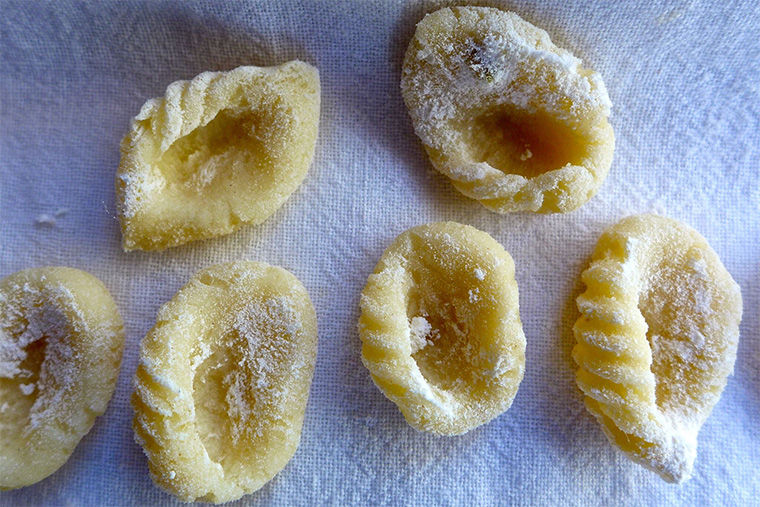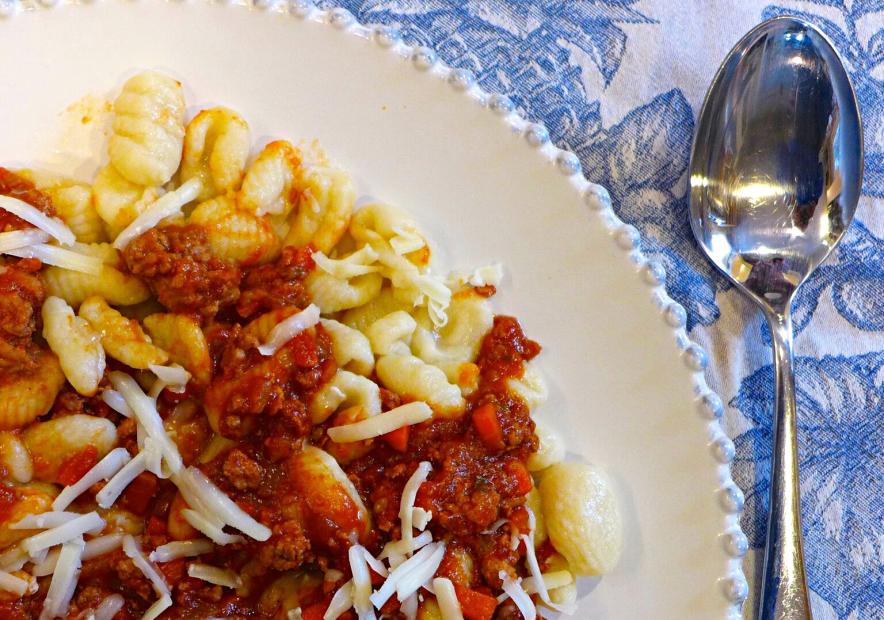Carnevale in Italy is a farewell to winter and a delirious celebration of Spring and all things delicious and forbidden. Every city or town has its own emblematic festival foods that are imbued with symbolic meaning. Naples is devoted to elaborate versions of lasagne al forno, Ivrea to big public bean feasts (fagiolate). Venice revels in ethereal fried pastries the locals call galani. Verona, on the other hand, exalts potato gnocchi when, on the last Friday of carnevale, it erupts into Venerdì Gnoccolare (“Gnocchi Friday”).
The titular head of the festivities is Il Papà del Gnocco, a gnome-like gnocchi king elected every year for the occasion. Bearing a scepter on which is impaled a giant gnocco and wearing the colors of potato dumplings and meat sauce, he leads a raucous parade of costumed locals on horseback, bands, minstrels, acrobats on stilts, merrymakers, floats lampooning politicians and clerics, and carts filled with food through the ancient city streets. The crowd winds up in Piazza San Zeno where they are joined by the rest of the townspeople for a public gnocchi pig-out.

For those not familiar with Verona history, Piazza San Zeno is the site of a battle that took place in A.D. 489 when the Goth king, Theodoric, defeated barbarian armies, winning sovereignty for the city. The king gave his subjects the legions of slain horses, which they quickly butchered and marinated in wine and aromatics for many days. The result was pastissada, a ragù of horsemeat (make it with beef, buffalo or venison), perfumed with the Valpolicella or Amarone wine of Verona. How to describe the sauce? As the Veronese would say, “Veronesissimi”—very, very Veronese! As for the gnocchi, while originally they were made from nothing more than flour and water, today they are based on potatoes. So passionate are the people of Verona about the potato dumplings that they have coined a word for the aftereffects of eating too much of them: GNOCCOLONITÀ, “gnocchi-ism.”
Recipes for the gnocchi and the meat sauce follow. Prepare the pastissada first. This can be done a day or two ahead of making the gnocchi.

Pastissada
For 4 people
Recipe from Veneto: Authentic Recipes from Venice and the Italian Northeast, by Julia della Croce (Chronicle Books, 2002)
3 tablespoons unsalted butter
2 tablespoons extra-virgin olive oil
1/4 pound pancetta, minced
1 large clove garlic, minced
1 onion, chopped
1 large carrot, peeled and chopped
1 celery stalk, including leaves, chopped
1 bay leaf
scant 1/2 teaspoon ground coriander
1/4 teaspoon ground cloves
1-1/2 pounds ground beef, bison, or venison
1/2 pound chicken giblets, trimmed of fat and membranes, chopped
2/3 cup Valpolicella, Amarone, or other good dry red wine
3 tablespoons tomato paste
3-1/2 cups canned peeled plum tomatoes in their own juice, chopped
1 teaspoon sea salt, or to taste freshly ground white or black pepper
1. In a large saucepan, warm the butter with the oil over medium-low heat. When it is hot, add the pancetta and sauté until golden, 7 to 9 minutes. Stir in the garlic, onion, carrot, celery, bay leaf, coriander, and cloves and sauté without browning until the vegetables are well softened, 12 to 15 minutes.
2. Add the ground meat and the giblets to the pan, using a wooden spoon to break them up. Turn the meats over to saute it evenly, cooking until it is lightly colored, 5 to 7 minutes. Pour in the wine and allow the alcohol to evaporate, about 3 minutes. Stir in the tomato paste and sauté gently for 2 to 3 minutes. Add the chopped tomatoes and salt.
3. Cover the pan partially and simmer over low heat, stirring occasionally, until the sauce thickens, about 1-½ hours. If it seems to be drying out, add a few tablespoons of water as needed to moisten. Remove the bay leaf. Serve the meat sauce over freshly made potato gnocchi. Eat at once.

Potato Gnocchi
For 6 people
Recipe from Veneto: Authentic Recipes from Venice and the Italian Northeast, by Julia della Croce (Chronicle Books, 2002) It is impossible to give an exact recipe for potato gnocchi because the amount of flour needed depends on the moisture content of the potatoes, but there is one hard and fast rule: the less flour, the lighter the gnocchi. Because the ideal is to introduce as little flour as possible, the potatoes should be cooked in their skins. To mash the potatoes after cooking, use a potato ricer. A hand-masher or fork does not remove lumps, while a food processor makes cooked potatoes gluey.
For the gnocchi:
2 pounds Yukon Gold potatoes of uniform size
1 egg
1/8 teaspoon freshly milled, finely ground white pepper
1 teaspoon fine sea salt
1-1/2 cups all-purpose flour, plus additional as needed
2 tablespoons kosher salt for cooking gnocchi
1. Place the potatoes in the top insert of a steamer; fill the bottom pot with water. Bring to a boil. Cook the potatoes until completely tender, using a skewer or fork to test for doneness. While the potatoes are cooking, line three baking sheets with clean kitchen towels; set aside.
2. Have ready a slotted spoon, a large, wide colander positioned over a pan, or a slotted broiler tray, and a large wide, shallow serving dish in which to transfer the gnocchi once they’ve drained. Smear it with a little of the sauce you will be using and keep it warm. Fill a large kettle three-quarters full of water (about 5 quarts), cover, and bring to a rapid boil.
3. When the potatoes are cool enough to handle but still warm, peel them, using a paring knife to lift off their skins. The potatoes must still be warm when combined with the flour. Pass the potatoes through a ricer directly into a large bowl. Add the egg, salt, and pepper. Turn the mixture out onto an ample, floured work surface.
4. Incorporate the flour into the potatoes, drawing the flour in as you work the mass into a tender dough. The amount of flour that will be absorbed will depend on the moisture content of the potatoes, so the flour should be worked in gradually. It is important not to overwork the dough. It should be quite soft without being at all sticky.
5. Divide the dough into eight equal parts. Work with one piece of the dough at a time. Keep the remaining dough covered with an inverted bowl until you are ready to use it.
6. Using your hands, roll the dough into a rope about 3/4-inch thick. Cut the rope into approximate 3/4-inch pieces; 1/2-inch pieces for gnocchetti. Using the side of a grater, or a ridged wooden butter paddle, take each little piece one at a time and holding it between your thumb and your forefinger, drag it along the face of the grater with the medium-sized holes (the same side of the grater that would be used for grating hard cheese), pushing your thumb into it as you do so. A hollow, concave dumpling will result (the hollow formed in the center makes them light and allows the gnocchi to cook evenly throughout). Transfer the finished gnocchi to the prepared cloth-lined baking sheets, arranging them in a single layer without touching. Approximately the same quantity of gnocchi should be placed on each sheet. If the dough becomes a little sticky as you work with it (this is bound to happen with succeeding batches), sprinkle the ropes and the grater or paddle lightly with flour. If the dough is too sticky altogether, form it into a ball again and knead in only as much flour as necessary to prevent the stickiness. Finish making the rest of the gnocchi with the dough that is left.
7. To cook the gnocchi, pick up one of the cloths holding a third of the gnocchi, grabbing two corners in each hand, and tip and slide the gnocchi directly into the rapidly boiling water. Immediately add 2 tablespoons of salt and using a long-handled wooden spoon, stir immediately. As soon as the gnocchi float to the surface, scoop them out with the slotted spoon and transfer them to an ample serving platter. Spread them out to prevent them from clinging together.
8. Spoon the pastissada sauce over the gnocchi and scatter the grated cheese lightly over the top. Serve immediately.
Ahead-of-time note: Once formed, the baking sheets full of gnocchi can be covered with foil or waxed paper and refrigerated for up to 3 hours. For longer storage, freeze the gnocchi on their trays. Once frozen, the gnocchi can be transferred to a plastic bag or container and frozen for up to 1 month. To cook, drop frozen gnocchi directly into boiling salted water; cook until they float to the surface and serve as directed above.
Julia della Croce is a food writer and James Beard award-winning cookbook author and recipe developer based in New York. She is presently incubating a book about her family’s ancestral region, Sardegna. Visit her website, www.juliadellacroce.com and blog, http://juliadellacroce.com/forktales1/, connect on Facebook: Julia della Croce – chef & foodwriter, Twitter: @juliadellacroce and Instagram: juliadellacroce.






























